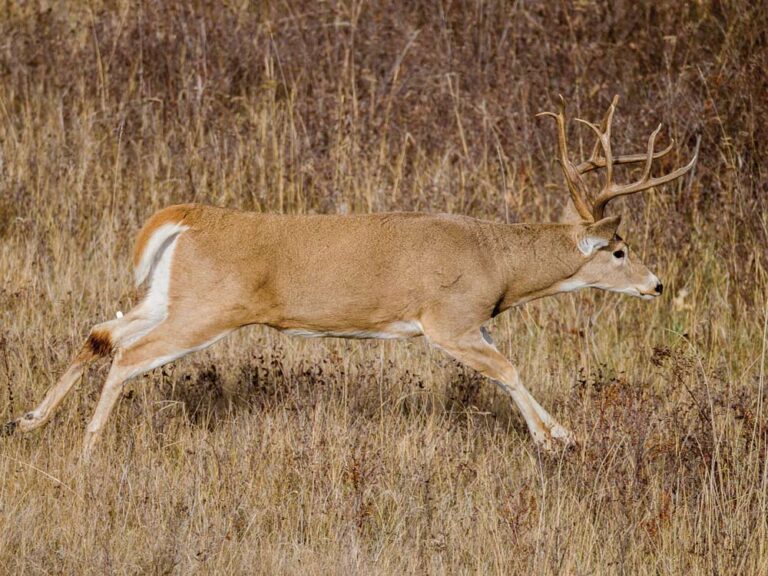Do Deer Travel the Same Path Every Day
Deer often follow the same paths daily as a result of their habitual nature and desire for safety. These paths, known as deer trails, are created over time through repeated use.
Deer are creatures of habit, consistently using established trails for their daily routines. These trails provide a safe and efficient route for foraging, accessing water, and evading predators. This predictable behavior is key for survival in the wild, as familiarity with the landscape can significantly reduce the risks faced by these animals.
Understanding these patterns is crucial for wildlife enthusiasts, hunters, and naturalists aiming to observe or manage deer populations. Observing the daily movements of deer not only offers insights into their behavior but also reflects the interconnectedness of an ecosystem where every path plays a role in the broader canvas of wildlife activity.
Understanding Deer Behavior
White-tailed deer, majestic and wary, are creatures of habit, though their routines are not etched in stone. While they often frequent the same trails, subtle changes in their environment can lead to significant alterations in their movement patterns. Grasping the intricacies of deer behavior means taking a closer look at what drives these graceful animals to roam the forests and fields the way they do.
Seasonal Movement PatternsSeasonal Movement Patterns
Deer behavior shifts with the changing seasons, responding to the climate’s rhythm and its impact on their daily lives. Each season dictates a unique set of movement patterns, influenced by mating habits, weather conditions, and feeding needs.
- Spring: With winter’s scarcity behind them, deer seek out rebirthed food sources and tend to have dispersed movements.
- Summer: The search for cool, dense foliage for cover and foraging leads deer to establish more consistent paths.
- Fall: The rut, or mating season, stirs bucks to travel more widely and erratically in search of does.
- Winter: Harsh conditions and limited resources funnel deer into more predictable patterns, often using well-trodden paths to conserve energy.
Understanding these patterns is crucial for wildlife enthusiasts and hunters alike as they prepare to observe or manage deer populations throughout the year.
Impact of Food AvailabilityImpact Of Food Availability
Food is a powerful motivator for all wildlife, and deer are no exception. Availability, or lack thereof, of natural forage can dramatically reshape a deer’s daily journey. Seasons play a pivotal role in this, but so do other environmental factors, such as agricultural practices and urban development.
| Condition | Deer Response |
|---|---|
| Abundant Natural Food | Paths may remain consistent as food sources are predictable and reliable. |
| Scarce Resources | Deer are likely to expand their range and alter their paths in search of sustenance. |
| Human-Altered Landscapes | Adaptation to new food sources, possibly leading to altered paths that include residential or agricultural areas. |
In areas where food plots or feeders are established, deer may develop new travel routines to take advantage of these resources. Land management practices that enhance or diminish food availability can have a direct and immediate impact on the daily paths of deer.
Factors Influencing Daily Deer Paths
Understanding the factors influencing daily deer paths is crucial for wildlife enthusiasts, hunters, and conservationists alike. Deer are creatures of habit, but their movements are not just random meanderings. Instead, they are the result of a complex interaction of various stimuli and pressures from their environment. Below, we delve into the specific factors that play a crucial role in determining the route a deer may take on any given day.
Environmental Influences
The environment has a profound effect on the daily paths chosen by deer. Key elements such as:
- Food sources: Deer are primarily driven by the availability of food. They often follow paths that lead to their preferred feeding areas, which can change seasonally.
- Water availability: As with any animal, deer need water for survival. Proximity to water sources can dictate their travel patterns, especially during dry conditions.
- Seasonal changes: As seasons transition, so do the habitats and resources within them. Deer adapt their paths in response to these changes, seeking out the best conditions for shelter and forage.
- Topography and obstacles: Natural features such as hills, valleys, rivers, and thickets can guide or impede a deer’s movement. Deer will often use the landscape to their advantage, conserving energy by using established trails.
Predation Risk
Another significant factor that influences deer paths is the risk of predation. Deer are constantly on the alert for predators, and this heavily influences their behavior:
- Scent and sight lines: Deer tend to choose paths that offer the best opportunities to detect predators early. Pathways downwind of potential hiding spots for predators are often avoided.
- Escape routes: Paths that provide clear escape routes are preferred. These might include areas that allow for quick sprints or access to difficult terrain where predators cannot easily follow.
- Time of day: Deer may alter their paths based on the time of day to minimize encounters with predators. For example, they may be more cautious and select safer routes during dawn or dusk when predators are more active.
- Predator density: In areas with a high density of predators, deer might avoid certain paths altogether, choosing safer routes even if they are longer or more energy-intensive.
How Deer Determine Their Path
Understanding the behavior of deer and their movement patterns can be fascinating for wildlife enthusiasts and essential for deer management strategies. How Deer Determine Their Path is a complex process influenced by various environmental and social factors. By unraveling these intricate navigation habits, we not only gain insight into the lives of these majestic creatures but also enhance our ability to coexist with them harmoniously.
Use Of Scent Marking
Among the primary techniques deer employ to navigate their environment is scent marking. This method involves leaving behind a unique signature that not only marks their territory but also guides their movement. Deer have specialized glands located around their face, legs, and hooves that produce scents which play a vital role in their communication. These scent trails assist deer in:
- Establishing their home range: Deer create recognizable areas within their habitats.
- Finding food sources: By following scent trails, deer can locate previous feeding areas.
- Mating: Scents help bucks locate does during the breeding season.
- Reconnecting: Lost or separated deer can find the herd by following these scent markers.
Individual And Group Behavior
Deer behavior, whether as solitary animals or as part of a group, also dictates the paths they travel. An individual deer might follow a habitual route that’s been successful in avoiding predators and locating resources. In contrast, group dynamics can lead to a consensus in route selection. Factors influencing their paths include:
| Behavior Type | Path Influencers |
|---|---|
| Individual | Past experiences, food supply, predator encounters |
| Group | Social hierarchy, collective memory, safety in numbers |
Deer herds often move together, guided by a dominant member with the most experience, which minimizes risks and increases the efficiency of their movements. The paths they take might change with the seasons, available food sources, and breeding habits, but the underlined behaviors stay persistent. Understanding these patterns aids in predicting deer movements, a crucial element for both wildlife observation and management.
Variation In Deer Travel Patterns
Deer are creatures of habit, often seen grazing or moving in the same general area. But do they follow the exact same path each day? Not necessarily. While it’s true that deer tend to use familiar trails, a number of factors can cause variations in their daily routes. Understanding these variations can provide a fascinating insight into the behavior of these elusive creatures and enhance our wildlife management practices.
Changes In Season And Weather
As the seasons turn, deer adjust their behavior to adapt to the changing environment. During spring and summer, a plethora of available resources means paths may vary widely as deer forage for food. In contrast, the fall rut, or breeding season, sees male deer traveling more unpredictably as they search for mates.
Winter offers its own challenges. Food scarcity and harsh conditions force deer to utilize more consistent pathways to known food sources. Yet, profound weather changes like snowfall and freezing temperatures can alter these paths abruptly.
- Spring/Summer: Diverse foraging paths
- Fall: Unpredictable movements due to mating
- Winter: Consistent routes to food, altered by severe weather
Human Disturbance
Human activity inevitably impacts deer travel patterns. Construction, recreation, and changes in land use could all disrupt established trails and force deer to find new routes. This can lead to increased visibility in areas where deer previously traveled unseen, or conversely, cause deer to become more secretive and stick to cover.
Noticing shifts in these travel patterns can be particularly helpful for hunters and wildlife observers, signaling where deer might emerge based on human presence and activity.
| Type of Activity | Deer Travel Impact |
|---|---|
| Construction | Disrupts trails, creates new routes |
| Recreation | May cause avoidance behavior |
| Land Use Change | Forces adaptation to new environments |
In conclusion, while deer might have preferred pathways, seasonal shifts, weather variations, and human activities all play significant roles in influencing their daily routes. By observing these factors, we gain a deeper understanding of deer behavior and can better anticipate their movements through the landscape.
Human Interaction And Deer Routes
The daily movements of deer can seem like a mystery, an elegant dance through nature’s corridors. Yet, the spaces they traverse are often shared or influenced by humans Human interaction plays a significant role in determining the paths these animals take, sometimes leading to predictable patterns, other times causing them to adapt in unforeseen ways.
Effects Of Human Activity
Deer are highly adaptable creatures, but they’re also sensitive to changes within their ecosystem, especially those brought about by human activities. Trails often used by deer may see a shift when encountering areas of high human traffic or development. Recreational activities such as hiking, biking, and off-roading can cause disturbances, leading deer to alter their established routes to avoid human interaction. Conversely, some deer may grow acclimatized to human presence, following paths that opportunistically benefit from human food sources or landscaped environments.
- Construction: can disrupt natural paths, forcing deer to find detours.
- Pollution: Noise and light pollution may deter deer from their regular routes.
- Feeding: Unintentional food sources can attract deer to human-inhabited areas.
Habitat Fragmentation
One of the most profound effects of human interaction on deer routes is habitat fragmentation. As development carves up the continuous stretches of woodland and meadows deer rely on, these animals must navigate a patchwork of suitable spaces. Often, this means crossing roads and bridges, venturing close to human habitations, or squeezing through ever-narrower greenways. The fragmentation not only alters their daily pathways but can also have cascading impacts on their behavior, breeding patterns, and food sources.
| Fragmentation Cause | Impact on Deer Routes |
|---|---|
| Road Construction | Makes existing paths perilous and encourages risky crossings. |
| Urban Expansion | Limits natural corridors, resulting in new, often less ideal routes. |
| Agricultural Development | Transforms foraging areas, forcing deer to travel further for food. |

Credit: www.grandviewoutdoors.com
Frequently Asked Questions Of Do Deer Travel The Same Path Every Day
Do Deer Follow Consistent Daily Paths?
Deer often utilize established trails, which can provide consistent paths day-to-day. These paths offer safety and energy-efficient routes between feeding, bedding, and water sources.
What Factors Influence Deer Travel Patterns?
Deer travel patterns are influenced by food availability, predator risk, terrain, weather conditions, and the need for mating. Seasonal changes can significantly alter these patterns.
How Do Seasonal Changes Affect Deer Movement?
Seasonal changes greatly impact deer movement. Mating season, food sources, and weather drive deer to alter their paths. For example, deer may travel more during the fall rut.
Can Human Activity Alter Deer Travel Routes?
Yes, human activity, such as development, hunting pressure, and farming, can disrupt natural habitat and force deer to find new travel paths or adjust their existing ones.
Conclusion
Understanding the movement patterns of deer enhances our knowledge of their behavior and ecology. While they may favor certain routes, variability is key to their survival. Remember, their paths can shift with environmental changes or disturbances. Ultimately, tracking these majestic creatures demands both patience and respect for their adaptive nature.





